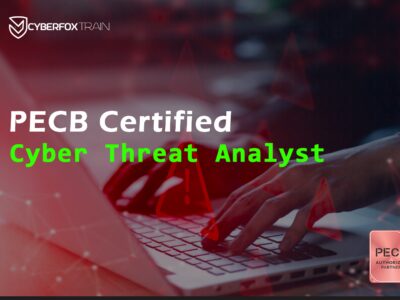Certified Threat Intelligence Analyst (CTIA) Training and Certification
The Certified Threat Intelligence Analyst (CTIA) program is designed and developed in collaboration with cybersecurity and threat intelligence experts across the globe. The aim is to help organizations hire qualified cyber intelligence trained professionals to identify and mitigate business risks by converting unknown internal and external threats into quantifiable threat entities and stop them in their tracks. Much like a ‘hunter-killer’ team, you’ll be deployed as a ‘Blue Team’ operative, tasked with threat identification, and asked to employ the tools at hand to thwart active and potential cyberattacks.
Certified Threat Intelligence Analyst (CTIA) from EC-Council is a credentialing certification and training program. This highly valued certification has been exclusively devised in collaboration with threat intelligence and cybersecurity experts worldwide to empower organizations effectively to identify and mitigate security risks with extensive processing and analysis of available threat information. The CTIA is a specialist level training and certification that demonstrates security professionals the structured approach to acquiring threat intelligence. The CTIA certified candidates attain a competitive edge over other information security professionals. This threat intelligence certification course delivers standards-based, intensive practical skills to the most essentially required threat intelligence across information security
Course Objectives
After completing this course you should be able to understand:
- Key issues plaguing the information security world
- Importance of threat intelligence in risk management, SIEM, and incident response
- Types of cyber threats, threat actors and their motives, goals, and objectives of cybersecurity attacks
- Fundamentals of threat intelligence (including threat intelligence types, lifecycle, strategy, capabilities, maturity model, frameworks, etc.)
- Cyber kill chain methodology, Advanced Persistent Threat (APT) lifecycle, Tactics, Techniques, and Procedures (TTPs), Indicators of Compromise (IoCs), and pyramid of pain
- Various steps involved in planning a threat intelligence program (Requirements, Planning, Direction, and Review)
- Different types of data feeds, sources, and data collection methods
- Threat intelligence data collection and acquisition through Open Source Intelligence (OSINT), Human Intelligence (HUMINT), Cyber Counterintelligence (CCI), Indicators of Compromise (IoCs), and malware analysis
- Bulk data collection and management (data processing, structuring, normalization, sampling, storing, and visualization)
- Different data analysis types and techniques including statistical Data Analysis, Analysis of Competing Hypotheses (ACH), Structured Analysis of Competing Hypotheses (SACH), etc.)
- Complete threat analysis process which includes threat modeling, fine-tuning, evaluation, runbook, and knowledge base creation
- Different data analysis, threat modeling, and threat intelligence tools
- Threat intelligence dissemination and sharing protocol including dissemination preferences, intelligence collaboration, sharing rules and models, TI exchange types and architectures, participating in sharing relationships, standards, and formats for sharing threat intelligence
- Effective creation of threat intelligence reports
- Different threat intelligence sharing platforms, acts, and regulations for sharing strategic, tactical, operational, and technical intelligence
Why Become a Certified Threat Intelligence Analyst?
- Compliant with JTA listed under the ‘Analyze’ category of NICE 2.0
Our cyber threat intelligence training program employs a rigorous Job Task Analysis (JTA) of the job roles involved in the field of threat intelligence. This makes it the ideal threat intelligence course for professionals to excel in the cybersecurity domain.
- Increased employability, geometrically
The cyber threat intelligence training empowers you with the latest techniques and tools to detect, engage, and neutralize cyberattacks in real time. This puts you in a unique place where recruiters are just waiting to grab skilled professionals, like you!
- Developed by global subject matter experts (SMEs)
EC-Council’s cyber intelligence analyst certification is developed using inputs and a vast pool of talent from global subject matter experts. A comprehensive cyber intelligence course, covering the A to Z of threat intelligence.
Certification:
The C|TIA exam can be challenged post the completion of attending the complete official C|TIA course. Candidates that successfully pass the exam will receive their C|TIA certificate and membership privileges. Members are required to adhere to the policies of EC-Council’s Continuing Education Policy.
Who Is It For?
- Ethical Hackers
- Security Practitioners, Engineers, Analysts, Specialist, Architects, and Managers
- Threat Intelligence Analysts, Associates, Researchers, Consultants
- Threat Hunters
- SOC Professionals
- Digital Forensic and Malware Analysts
- Incident Response Team Members
- Any mid-level to high-level cybersecurity professionals with a minimum of 2 years of experience.
- Individuals from the information security profession and who want to enrich their skills and knowledge in the field of cyber threat intelligence.
- Individuals interested in preventing cyber threats.
Course Content
Introduction to Threat Intelligence
- Understanding Intelligence
- Understanding Cyber Threat Intelligence
- Overview of Threat Intelligence Lifecycle and Frameworks
Cyber Threats and Kill Chain Methodology
- Understanding Cyber Threats
- Understanding Advanced Persistent Threats (APTs)
- Understanding Cyber Kill Chain
- Understanding Indicators of Compromise (IoCs)
Requirements, Planning, Direction, and Review
- Understanding Organization’s Current Threat Landscape
- Understanding Requirements Analysis
- Planning Threat Intelligence Program
- Establishing Management Support
- Building a Threat Intelligence Team
- Overview of Threat Intelligence Sharing
- Reviewing Threat Intelligence Program
Data Collection and Processing
- Overview of Threat Intelligence Data Collection
- Overview of Threat Intelligence Collection Management
- Overview of Threat Intelligence Feeds and Sources
- Understanding Threat Intelligence Data Collection and Acquisition
- Understanding Bulk Data Collection
- Understanding Data Processing and Exploitation
Data Analysis
- Overview of Data Analysis
- Understanding Data Analysis Techniques
- Overview of Threat Analysis
- Understanding Threat Analysis Process
- Overview of Fine-Tuning Threat Analysis
- Understanding Threat Intelligence Evaluation
- Creating Runbooks and Knowledge Base
- Overview of Threat Intelligence Tools
Intelligence Reporting and Dissemination
- Overview of Threat Intelligence Reports
- Introduction to Dissemination
- Participating in Sharing Relationships
- Overview of Sharing Threat Intelligence
- Overview of Delivery Mechanisms
- Understanding Threat Intelligence Sharing Platforms
- Overview of Intelligence Sharing Acts and Regulations
- Overview of Threat Intelligence Integration
Course Features
- Lecture 0
- Quiz 0
- Duration 3 days
- Skill level All levels
- Language English
- Students 20
- Assessments Yes






